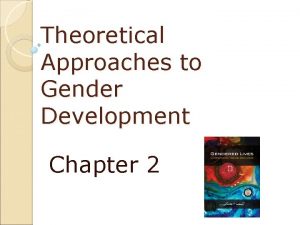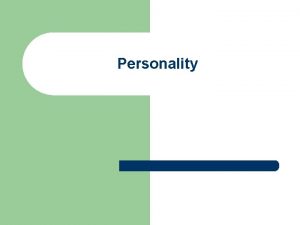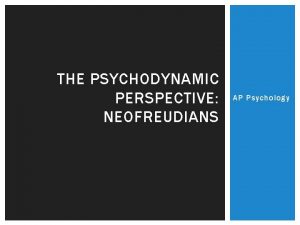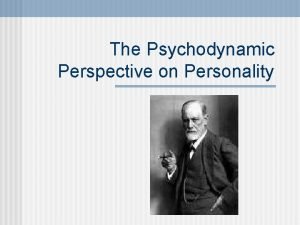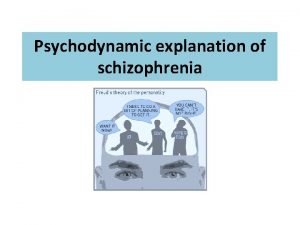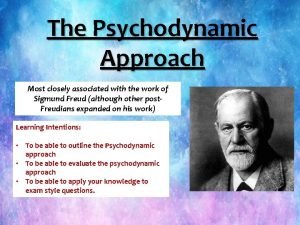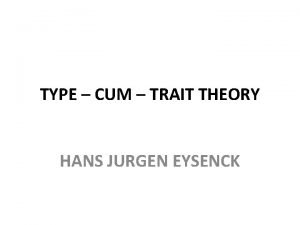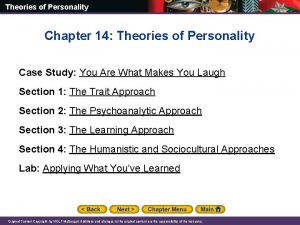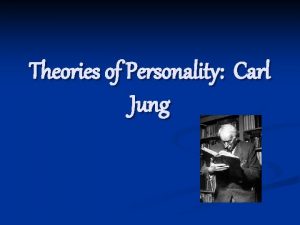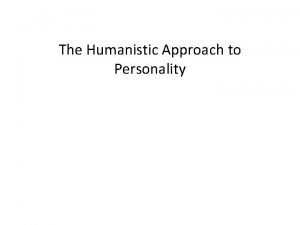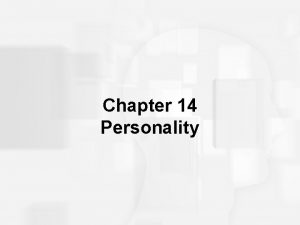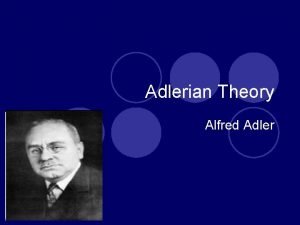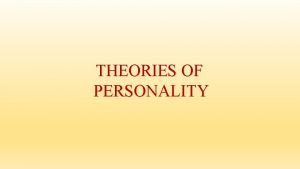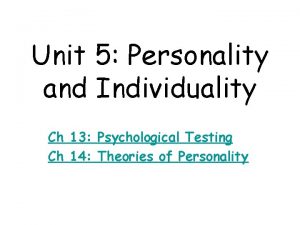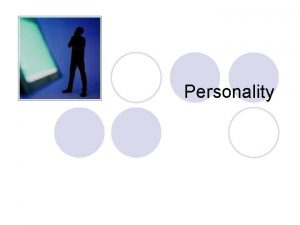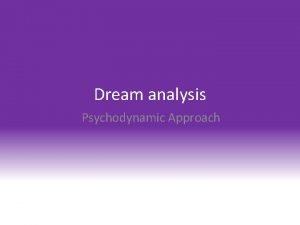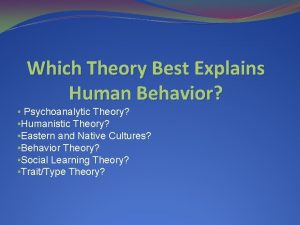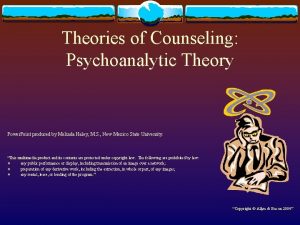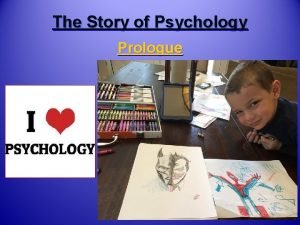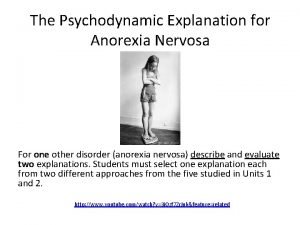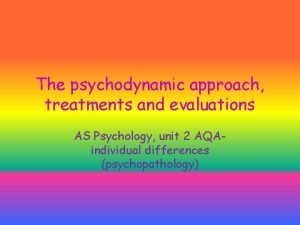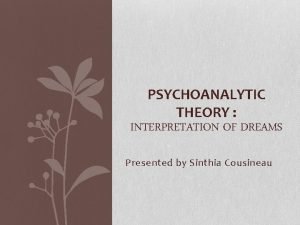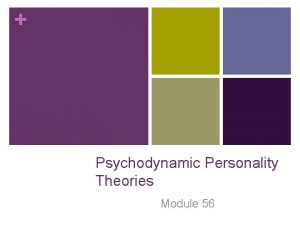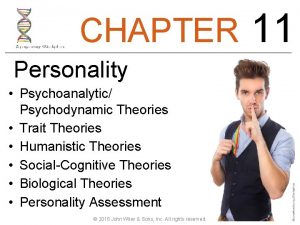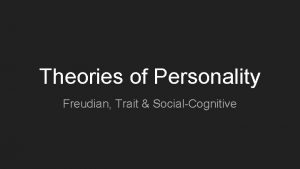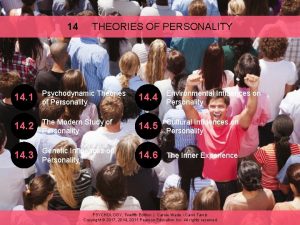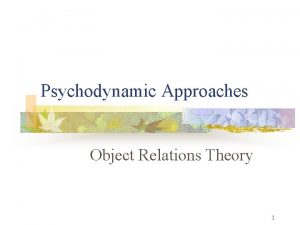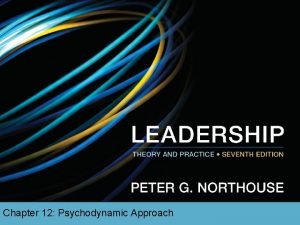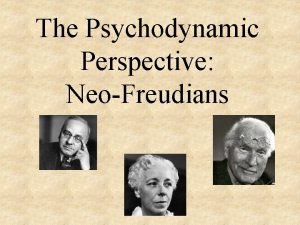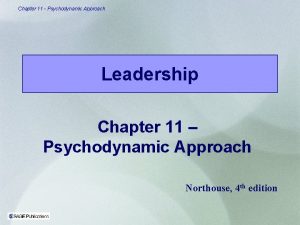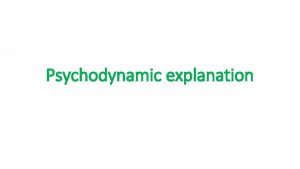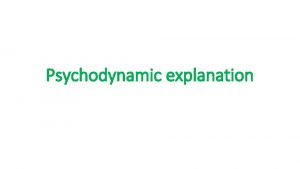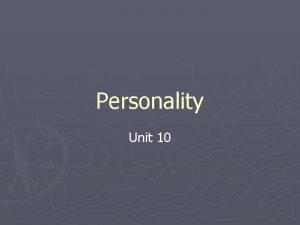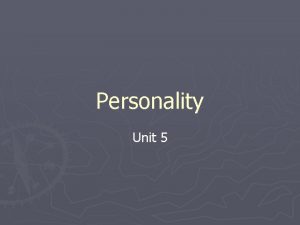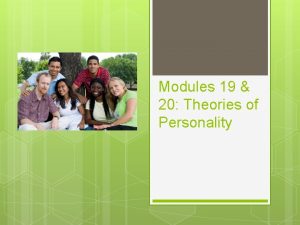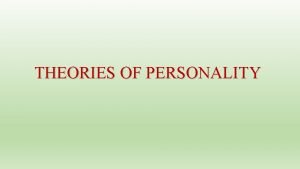PERSONALITY AND PSYCHODYNAMIC THEORIES WHAT IS PERSONALITY Most



























- Slides: 27

PERSONALITY AND PSYCHODYNAMIC THEORIES

WHAT IS PERSONALITY? • Most current definitions refer to personality as an individual's unique pattern of thoughts, feelings and behaviour that are relatively stable over time and across situations. • Essentially, this means that personality is your unique way of thinking, feeling and behaving in a wide range of situations throughout most of your lifetime.

CAN PERSONALITIES BE EXACTLY THE SAME? • With more than 6. 75 billion people in the world, it is hard to believe that there are not at least two individuals who are identical in every way. • Yet, this is the case — each person, including an identical twin, is a unique individual who has their own distinct mix of physical appearance, personality characteristics, biological make-up, ways of thinking, range of emotions, personal experiences and so on.

HOW DO YOU EXPLAIN DIFFERENT PERSONALITIES • Of all the factors which make us different from one another, personality is, for many people, the most intriguing, but also the most difficult to explain. • We frequently comment on the personality of others with statements such as, ‘She has a great personality’, or ‘All my friends think my mum is great, but they don't know what she's really like’. Or we describe someone as being ‘selfish’, ‘friendly’ or ‘shy’. You may have even heard someone talk about another person as having ‘no personality’!

EVERYONE HAS A PERSONALITY!

LOOK AT BOX 12. 1 • • • In your work books define the differences between Personality Temperament Character Mood

PERSONALLY WRITE DOWN ANY OF THE BELOW WORDS THAT DESCRIBE YOU. THEN DO THE SAME FOR THE PERSON SITTING NEXT TO YOU. aggressive shy rebellious ambitious emotional serious assertive sociable helpful creative clever impulsive trustworthy witty irritable organised romantic reliable calm dominant anxious pessimistic energetic trusting Develop a description of your personality using the words you have identified from the list. Your description can be written either from your own perspective, or as you believe others see you?

WHY DIFFERENT PERSONALITY THEORIES? • Psychologists who study personality approach their study from different perspectives. Consequently, a variety of theories have been developed to describe and explain how personality develops, why personalities differ and how personality is best measured or assessed. • Similarly, models have been developed to mainly describe the structure of personality and the elements that make up personality. Models differ from theories in that they tend to be less comprehensive.

THREE MAJOR GROUPS OF THEORIES IN PERSONALITY • Psychodynamic • Trait theories • Humanistic

THE THREE THEORIES • Each of these approaches to personality is based on a different set of assumptions and concepts. • Few psychologists believe that any one theory provides a complete or entirely satisfactory explanation of personality. • Each theory or model focuses on one or more aspects of human functioning and it is unlikely that any single theory or model of personality is adequate on its own to explain all aspects of personality. • Consequently, some psychologists tend to adopt an eclectic approach to explain personality; that is, combining parts from different theories and models to form an overall approach they find most useful.

COMPLETE LA 12. 2 • Questions 1 – 5 • Page 511

SIGMUND FREUD PSYCHODYNAMIC THEORIES

FREUD’S PSYCHODYNAMIC THEORY • The underlying belief of psychodynamic theories of personality is that personality is a result of unconscious psychological conflicts and how effectively these are resolved by the individual. • These conflicts have their origins in childhood experiences during which an individual's instinctive urges and society's view of what is ‘acceptable’ behaviour often clash. • The Austrian medical practitioner and psychoanalyst Sigmund Freud developed the psychodynamic approach to describing and explaining personality. • The psychodynamic approach is also called the psychoanalytic approach. Freud's observations of the ‘patients’ who came to see him about their psychological problems, observations of his family and his reflections on his own personal thoughts, feelings and behaviours provided the basis of his theory.

THE FIRST THEORY OF PERSONALITY • Freud's psychodynamic theory is considered to be the first developmental theory of personality in psychology. • It not only describes and explains how personality ‘develops’, but also describes and explains the development of personality throughout the entire lifespan

• Underlying Freud's theory of personality is his belief that the mind is very much like an iceberg — most of it is beneath the surface, hidden from the world and, in particular, hidden from ourselves (see figure below). Most of the time, we experience only the ‘tip of the iceberg’.

THE CONSCIOUS LEVEL • The conscious level is everything we are thinking, remembering, feeling, sensing or aware of at this particular moment. For example, your conscious awareness right now may be the words you are reading, what is for dinner tonight or how tired you feel. • Ideas and thoughts are constantly flowing in and out of the conscious mind. • Write an example of some of your conscious thoughts right now.

PRECONSCIOUS LEVEL • The preconscious contains much of the information which we often say is at the ‘back of our mind’ and it can easily be brought into our conscious mind by simply thinking about it. By performing the following exercise you will move thoughts from your preconscious to your conscious level of awareness. • Think of each of the following: the last class you had; when you last cleaned your teeth; to whom you last spoke; what you had for lunch yesterday; and an event which made you feel very pleased with yourself. • The conscious and preconscious are merely the tip and upper part of the ‘iceberg of the mind’. The bulk of the iceberg is made up of the unconscious.

UNCONSCIOUS LEVEL • The unconscious is a storage place for all the information about ourselves that is not acceptable to the conscious mind. • It is not, however, a storage place for all the information in our memory. It can be thought of as the ‘skeletons in the closet’ part of the mind where all the ‘unacceptable’ thoughts, feelings, experiences, images, impulses, motives and ideas are buried. • Freud believed the unconscious contains all the memories of experiences which may be emotionally painful, extremely frightening and very difficult for us to bring into our conscious minds. Although you are not directly aware of your unconscious thoughts and feelings, Freud believed they still have a considerable influence over your conscious thoughts and behaviour

The Structure of Personality • Freud believed that an individual's personality is fully formed by about five or six years of age and that what happens for the rest of their life is an expansion and refinement of this basic structure.

ID, EGO AND SUPEREGO • Freud used the terms id, ego and superego to describe three parts, or systems, that make up personality. At times, these operate cooperatively but most times they are in conflict within each of us.

THE ID • The id represents innate, biological needs which all of us are born with — those needs which help us survive. • These include such needs as hunger, thirst, sleep and sex. There is no part of our brain which we can point to and identify as the id. It is a construct, or a concept, described as a force, which represents the demanding, impulsive, illogical, irrational and extremely selfish part of our personality. • The id operates on the pleasure principle; it must have its needs met immediately to increase pleasure and to avoid pain to reduce tension caused when the body is in a state of need. • The id seeks immediate satisfaction, regardless of society's rules or the rights or feelings of others. If our behaviour was completely controlled by the id, we would demand to have our own way all the time. • As a class – think of how you would act if you lived just by the rules of your id

EXAMPLE OF THE ID – LIKE WHEN YOU ARE A BABY • The way in which the id operates may be observed in the behaviour of a newborn baby. • A newborn's behaviour is dominated completely by the id. Whenever the infant needs to be fed, is in pain, experiences discomfort or wants to be comforted, it cries immediately the need is experienced. • The infant has no consideration for the fact that it may be difficult for the caregiver to leave whatever they are doing to satisfy its needs at that moment. • The behaviour of most young children is driven primarily by the id — they want everything immediately, are unable to wait and demand to have their needs met

THE EGO • The ego develops gradually as the infant moves into childhood and begins to understand more about how the real world operates; that is, needs cannot always be satisfied immediately or, sometimes, at all. The ego operates on the reality principle — it tries to ensure the needs of the id are met, but in a socially acceptable way and at appropriate times. On the basis of the reality principle, the ego considers ‘real-life’ restrictions in dealing with id demands. Imagine what would happen if people expressed their sexual impulses whenever they ‘popped into their mind’, regardless of where they were!

EXAMPLE OF THE ID AND EGO • The ego is the part of our personality which is realistic, logical and orderly. The following example explains the relationship between the id and the ego more clearly. • Suppose that you have decided you will complete a Psychology assessment task tonight because it is due tomorrow. At 8. 30 pm, you still have about an hour's work left to complete the task. • A movie you really want to watch is just about to start on television. If the id is dominant, it will demand that you stop working, relax and watch the movie. If the ego is dominant, it will reason with the id that you should finish the assessment task, then relax, or should look for another solution, perhaps suggesting that you record the movie to watch on another night. • The ego therefore develops not to stop the impulses of the id and prevent its satisfaction, but rather to help control id impulses until they can be satisfied in socially appropriate ways. The ego plays a mediating role. It has to cope not only with id demands, but also with the demands of the superego.

THE SUPEREGO • The superego is our conscience, always looking over us, judging our thoughts, feelings and actions according to the morals and ideals of the society in which we live. • It operates by the moral principle, providing us with our ideas of what is right and wrong. The superego is responsible for our feelings of guilt when we do something wrong and our sense of pride when we do something right. • Our personal understanding of right and wrong is usually called a ‘conscience’.

THE SUPEREGO • The superego always aims for perfection and is not satisfied with anything less than that. • The main functions of the superego are to block the urges of the id, to persuade the ego to be moralistic rather than realistic, and to strive for perfection when thoughts, feelings or actions don't meet the superego's ideal standards. • It is a harsh judge and punishment is dealt out in the form of guilt.

ID, EGO AND SUPER EGO
 What theories
What theories Theoretical approaches to gender development
Theoretical approaches to gender development Cerebrotonic definition
Cerebrotonic definition Alfred adler ap psych
Alfred adler ap psych Ego defense mechanisms
Ego defense mechanisms Psychodynamic personality theory
Psychodynamic personality theory Psychodynamic approach to personality
Psychodynamic approach to personality The psychodynamic perspective
The psychodynamic perspective Type and trait theories of personality
Type and trait theories of personality What does the psychoanalytic approach to personality teach
What does the psychoanalytic approach to personality teach Carl jung theory
Carl jung theory Humanistic approach pros and cons
Humanistic approach pros and cons Theories of personality quiz
Theories of personality quiz Freudian theory consumer behaviour
Freudian theory consumer behaviour Adlerian
Adlerian Personality theories
Personality theories Raymond cattell was a psychologist who ________.
Raymond cattell was a psychologist who ________. Theories of personality
Theories of personality Therapies defined as “talk therapies” include
Therapies defined as “talk therapies” include Conclusion of schizophrenia
Conclusion of schizophrenia Psychoanalytic vs humanistic
Psychoanalytic vs humanistic Strengths and weaknesses of the psychodynamic approach
Strengths and weaknesses of the psychodynamic approach Site:slidetodoc.com
Site:slidetodoc.com Psychoanalysis
Psychoanalysis Psychodynamic psychologist
Psychodynamic psychologist Freud anorexia
Freud anorexia Psychodynamic approach evaluation
Psychodynamic approach evaluation Psychoanalytic theory dreams
Psychoanalytic theory dreams

